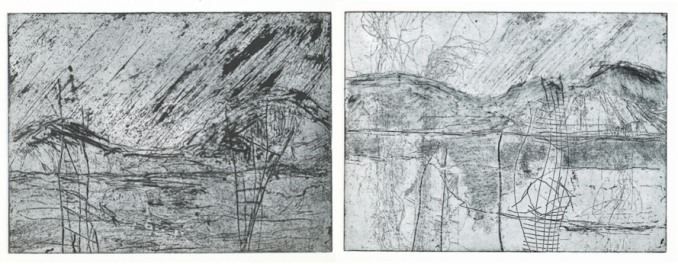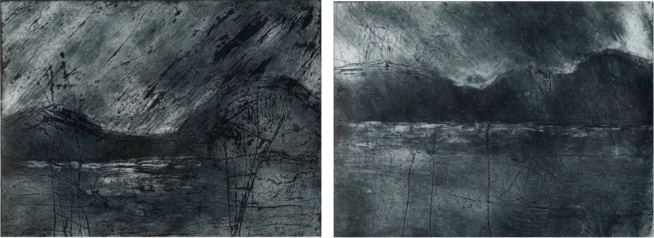In trying to capture a sense of place and a moment in time, I’ve been branching out with my printmaking to explore etching (soft ground and photo polymer). I have much to learn but was pleasantly surprised by the outcomes. I like the idea of the acid eroding the surface of the etching plate, almost like the effects of time, weather and water on the natural landscape.

 It was interesting to observe that I treated the etching plate as I would a monotype and through the inking process, tried to translate my emotional connection to the landscape. I wanted to capture light, mood and atmosphere.
It was interesting to observe that I treated the etching plate as I would a monotype and through the inking process, tried to translate my emotional connection to the landscape. I wanted to capture light, mood and atmosphere.

 Spending time along the West coast of Scotland and the Hebrides feeds constantly into my print work and my drawings. There is something really special about being out on a remote beach, far way from anyone. Immersed in the landscape and exposed to the extreme weather of strong winds, driving rain and moody skies. I enjoy watching storms forming and developing before my eyes, changing by the minute.
Spending time along the West coast of Scotland and the Hebrides feeds constantly into my print work and my drawings. There is something really special about being out on a remote beach, far way from anyone. Immersed in the landscape and exposed to the extreme weather of strong winds, driving rain and moody skies. I enjoy watching storms forming and developing before my eyes, changing by the minute.

 There is no substitute for physically being there, tasting and smelling the salt on my skin, feeling the cold wind penetrate my clothes. Nature’s elemental forces at their best. I want to capture that whole emotive and sensory experience of being there by the sea in all weathers and although my photographs provide a memory and capture a ‘moment in time’, they seem to lack something.
There is no substitute for physically being there, tasting and smelling the salt on my skin, feeling the cold wind penetrate my clothes. Nature’s elemental forces at their best. I want to capture that whole emotive and sensory experience of being there by the sea in all weathers and although my photographs provide a memory and capture a ‘moment in time’, they seem to lack something.
But what is a ‘moment in time’ ? Is it a ‘very brief portion of time, instant’? Is a moment in time that which ‘defines’ something? A point at which the essential nature … is ‘revealed or identified’? Its origin is directly taken from the Latin momentum ‘movement, motion; moving power; alteration, change’.
How would I capture this in a photograph or through drawing? The act of drawing within the landscape helps me to feel part of it, albeit an insignificant part. Everything I see, feel, hear and sense feeds into that drawing. It’s about translating and interpreting… a process of thinking and learning. I want much more than observational representation. I want to capture a sense of place, atmosphere, experience and translate change and time. I can relate to what printmaker Norman Ackroyd describes as “What I’m interested in”, says Ackroyd, “is making an emotional response, rather than just recording what is there”.


 I’ve mentioned previously that when my working process begins, the end is undetermined and unknown. The journey evolves. I recently came across an interesting word online ‘Coddiwomple’. The Old English Dictionary doesn’t seem to acknowledge it but I believe it means…..‘to travel in a purposeful manner towards a vague destination’ or ‘to travel purposely toward an as-yet unknown destination’ . This certainly sums up my practice in that I work purposely without knowing where it’s leading. As Gray & Malins (2004:2) describe an explorer of unknown terrain. (1)
I’ve mentioned previously that when my working process begins, the end is undetermined and unknown. The journey evolves. I recently came across an interesting word online ‘Coddiwomple’. The Old English Dictionary doesn’t seem to acknowledge it but I believe it means…..‘to travel in a purposeful manner towards a vague destination’ or ‘to travel purposely toward an as-yet unknown destination’ . This certainly sums up my practice in that I work purposely without knowing where it’s leading. As Gray & Malins (2004:2) describe an explorer of unknown terrain. (1)
I can understand the sentiments of artist John Virtue in that he only uses black and white in his work as he sees colour as an “unnecessary distraction”. When immersed in the landscape, there are so many ‘distractions’ of sounds, smells, taste, light, movement and atmosphere, it’s easy to feel overwhelmed. Time also (whether in seconds, minutes, hours or days) changes all of these. I think it will be some time before I venture into colour!
At some stage in the future, I would like to take my printmaking into the landscape to work directly on to the wax covered etching plate as Norman Ackroyd does. He comments “things that stirred me, I wanted to get to the root of” and in doing so, he will take ink, plate and acid into the field. The plate can be worked on directly, the acid painted on as if a watercolour, and the ‘bite’ stopped by a quick rinse in a stream or a wipe on the wet grass, giving a freedom and immediacy.
I haven’t yet experienced this ‘immediacy’ with etching but then my exploration has only just begun. I do enjoy the immediacy of monotypes and I recently exhibited a collection of these at the Blue Light Gallery in Masham, North Yorkshire. I also included a number of my monotypes in the Iron Press Printmaking print fair in Lancaster. Having not given much thought to selling my work, I was quite touched when visitors wanted to buy some of my prints. To think my prints are now displayed and being ‘enjoyed’ rather than being stored away in my studio plan chest is quite a lovely thought.




Quite separate to my own practice, if you recall I did some work for textile artist Alice Kettle last year on her ‘stitch a tree’ initiative, part of the multi stranded project Thread Bearing Witness. For those of you not familiar with my Facebook page, the aim was to connect communities and individuals around the world through the universal language of stitch, to show support for refugees and displaced people. People all ages contributed by stitching a tree and these were collated together into a ‘Forest’. We expected a couple of hundred stitched trees but the project escalated and we eventually received over 4,000 trees. I was delighted when I eventually got to see ‘Forest’ in situ, exhibited at the Whitworth Art Gallery in Manchester.



- Gray, C. and Malins, J. (2004) Visualizing Research: A Guide to the Research Process in Art & Design. Surrey: Ashgate Publishing Ltd
I absolutely love your words and images. Well worth the time and effort that I know you put in. You have a perception and a talent that you must nurture.
LikeLiked by 1 person
Thank you Gordon!! What lovely words. x
LikeLike
Really enjoying seeing your work Christine. Storms are fascinating as they move across the landscape and darkness looms. These drawings capture that feeling of being caught in a deluge and that it’s lashing it down!
LikeLiked by 1 person
Thanks Jo for your lovely comment. Love your description!!
LikeLike